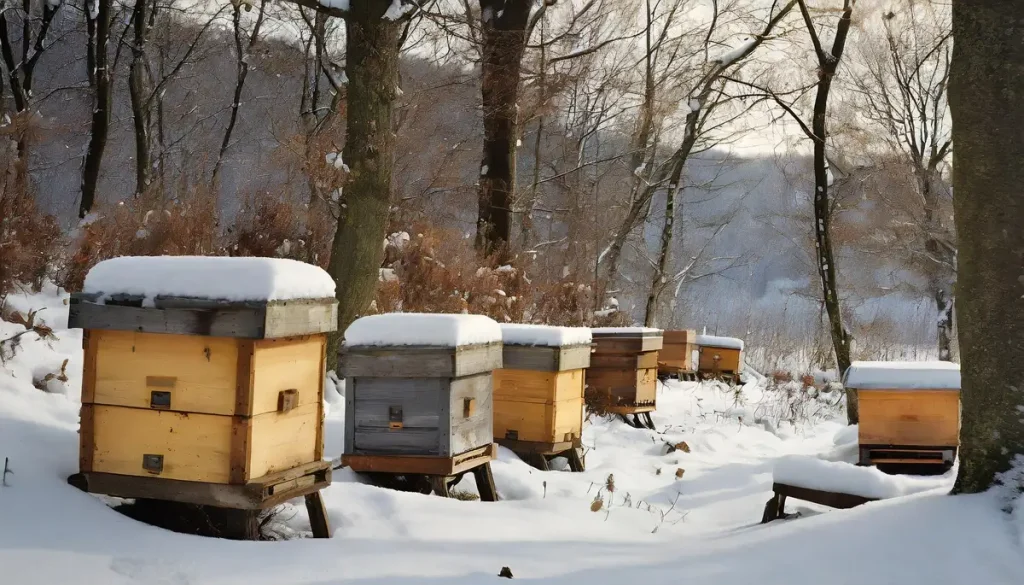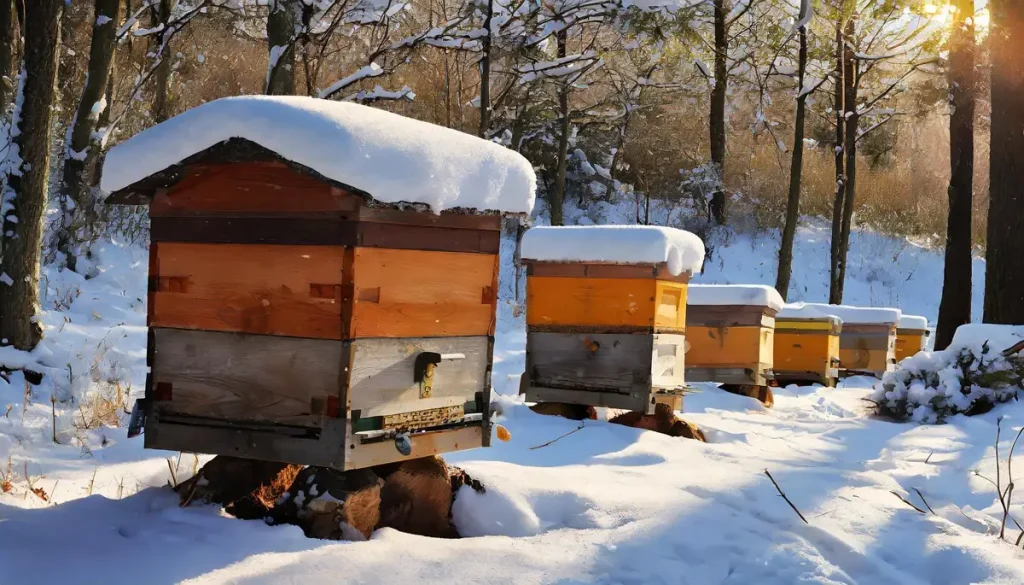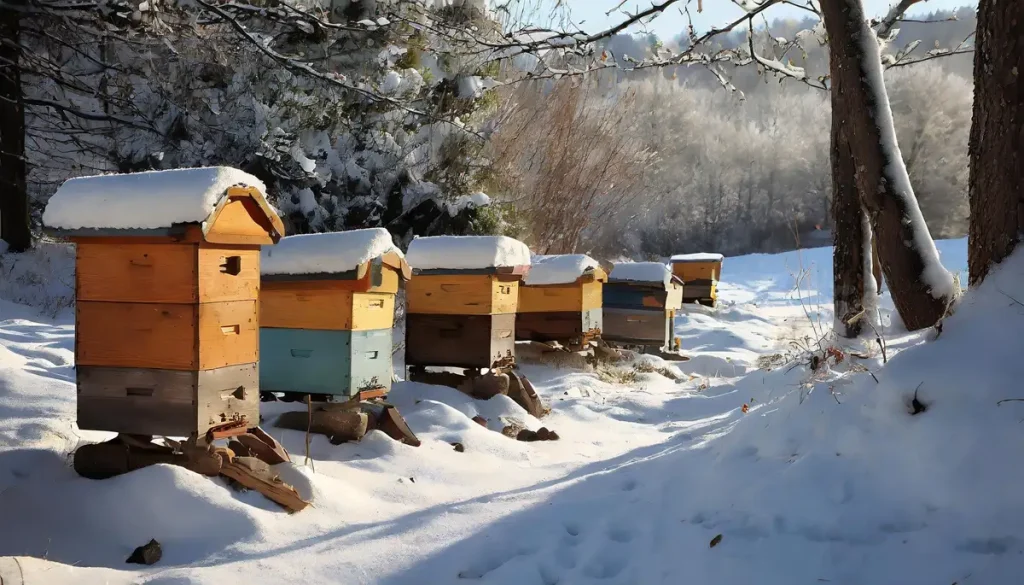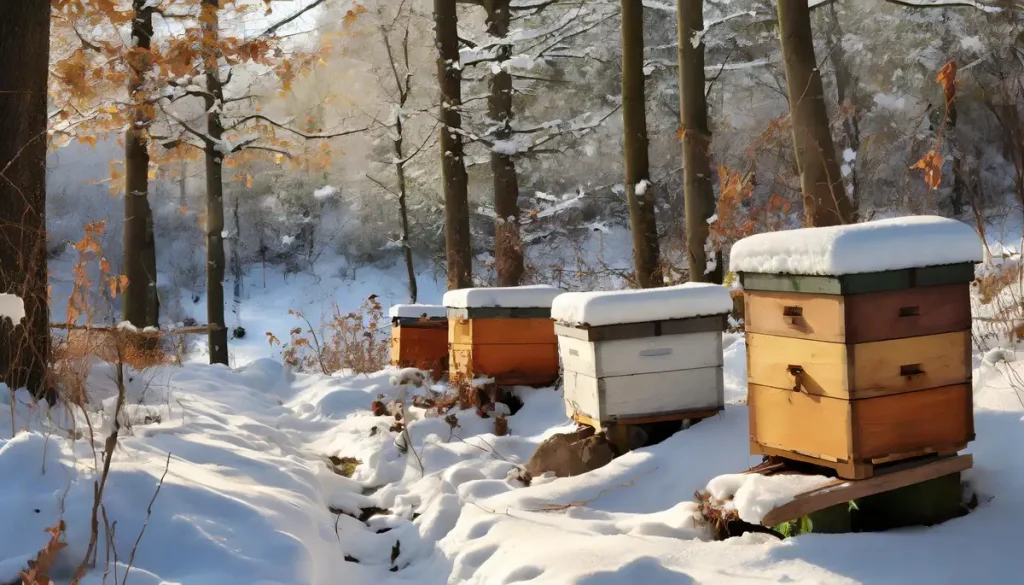Table of Contents
In winter, bees focus on survival, clustering inside their hives to maintain warmth. They form a tight group, known as a winter cluster, with the queen at the center. The bees on the outer edges of the cluster insulate those within, and they periodically switch places to ensure everyone stays warm. Worker bees consume stored honey as their primary energy source to generate heat through muscle contractions. The hive’s internal temperature is kept around 35°C (95°F) to protect the colony, including the developing brood. Bee activity significantly decreases, and they rarely leave the hive, only venturing out on warmer days for short cleansing flights.
In the below paragraphs, we will take a more detailed look at this topic.
As winter casts its frosty veil over the landscape, transforming the once bustling world into a silent, icy wonderland, the resourceful bees embark on a remarkable journey of survival. In this article I delve into the fascinating lives of these industrious insects at this time of year, revealing the intricate strategies they employ to withstand the harsh winter months. Venturing deep into the heart of their hives, I unravel the captivating behaviors and biological adaptations that equip bees to brave plummeting temperatures, scarcity of food, and the looming threats lurking in the shadows of the frozen world beyond.
What Is the Behavior of Bees in Cold Weather?
Bees exhibit unique behaviors in response to cold weather as they prioritize the survival of the colony and the queen during this challenging period. Their ability to adapt and endure harsh conditions is a testament to their resilience and resourcefulness.
Formation of the Winter Cluster
When temperatures drop, bees form a tight cluster within the hive to generate and conserve heat. Known as the “winter cluster,” this formation is crucial for the colony’s survival. The bees within the cluster huddle together, surrounding the queen and the brood, creating a protective barrier against the cold. They vibrate their wing muscles to produce heat, maintaining the temperature in the center of the cluster at approximately 95°F (35°C) to keep the queen and brood warm.
Metabolic Changes and Energy Conservation
During cold weather, bees undergo metabolic changes to conserve energy. They consume honey, which they have stored during the warmer months, as their primary food source. The honey provides the necessary carbohydrates to generate heat through their metabolism. Additionally, the bees’ metabolism slows down, which helps to conserve energy and reduce the need for foraging.
Limited Foraging and Flight
Foraging activities are significantly reduced during cold weather as bees are unable to fly effectively in low temperatures. Typically, they cease flying when temperatures drop below 50°F (10°C). On warmer winter days, worker bees may venture out briefly to defecate or to search for water, but they quickly return to the hive to avoid getting chilled.
Protective Measures
Bees also take measures to protect their hive from cold weather. They seal the hive entrance with propolis, a sticky, resinous substance they collect from plants, which helps to insulate the hive and maintain a stable internal temperature. They also regulate the hive’s humidity by fanning their wings to prevent condensation, which could lead to mold growth or dampness that would harm the bees.

Do All Bee Species Have the Same Winter Survival Strategies?
While all bee species face the challenge of surviving through the winter, their specific strategies for coping with cold weather can vary. The winter survival strategies of honeybees (Apis mellifera) have been discussed in previous sections, but let’s explore the different approaches of other bee species.
Bumblebees
Bumblebees (Bombus spp.) have a different life cycle compared to honeybees. During winter, only the fertilized queen bumblebees hibernate while the rest of the colony, including the workers and drones, die off. The queen seeks out a suitable location, such as an abandoned rodent burrow or a cavity in the ground, to spend the winter months. Throughout hibernation the queen’s metabolism slows down, allowing her to conserve energy until spring arrives. Come spring, she emerges to establish a new colony and lay eggs.
Solitary Bees
Unlike honeybees and bumblebees, which are social insects, solitary bees do not form colonies. There are numerous species of solitary bees, and their winter survival strategies can vary greatly. Some solitary bees, such as mason bees (Osmia spp.) and leafcutter bees (Megachile spp.), lay their eggs in nesting cavities during the warmer months. The larvae develop within these nests, feeding on a pollen-nectar mixture provided by the adult bee. When winter arrives, the larvae spin a cocoon and enter a state of diapause, a form of dormancy that allows them to survive the cold weather. They emerge as adult bees in the spring, ready to mate and continue the life cycle.
Carpenter Bees
Carpenter bees (Xylocopa spp.) are solitary bees that create nests in wood by excavating tunnels. Female carpenter bees lay eggs in these tunnels and provide their offspring with a pollen-nectar mixture for sustenance. The larvae develop within the tunnels, and once they reach the adult stage, they may overwinter in their nest. During this time, they remain inactive and rely on stored body fat to survive until the following spring.
- Carter, Anthony (Author)
- English (Publication Language)
- 194 Pages - 02/28/2024 (Publication Date) - Independently published (Publisher)
How Do Bee Colonies Prepare for Winter?
Bee colonies, particularly honeybee colonies, undergo several key preparations to ensure their survival during the harsh winter months. These preparations, a few of which were touched upon in the above paragraphs, include population management, resource storage, hive insulation, and entrance reduction. Each step plays a crucial role in helping the colony withstand cold temperatures and limited resources.
Population Management
In the months leading up to winter, the colony adjusts its population to optimize resource usage and survival. The queen gradually decreases her egg-laying rate, reducing the number of new bees in the hive. Simultaneously, the colony expels male bees, or drones, since they serve no purpose during winter and consume valuable resources. As a result, the winter bee population consists primarily of worker bees and the queen.
Resource Storage
Throughout the spring and summer worker bees forage for nectar and pollen, which are used to feed the colony and raise new brood. The nectar collected by bees is converted into honey, which serves as a vital food source during winter. The colony works diligently to store enough honey in the hive to sustain the entire colony throughout the colder months when foraging opportunities are scarce.
Hive Insulation
A well-insulated hive is crucial for maintaining warmth and conserving energy during winter. Honeybees produce a substance called propolis, a sticky, resinous material collected from plants. They use propolis to seal any gaps or cracks in the hive, improving insulation and helping to maintain a stable internal temperature.
Entrance Reduction
Reducing the entrance size of the hive is another preparation bees make for winter. By narrowing the entrance, the colony limits the amount of cold air entering the hive and makes it easier to maintain a consistent internal temperature. This reduced entrance also serves as a defensive measure, making it more difficult for pests and predators to enter the hive.
What Role Does Honey Play for Bees in the Winter?
Honey plays a crucial role in the survival of bees, particularly honeybees, during winter. As a high-energy food source, honey provides the necessary carbohydrates to fuel bees’ metabolism and maintain their energy levels throughout the cold months when foraging opportunities are scarce. The primary roles of honey for bees in the winter include providing energy for heat generation, sustaining the colony, and ensuring proper nutrition.
Energy for Heat Generation
During winter, honeybees rely on honey to generate heat within the hive. As the bees consume honey, they metabolize it, producing energy that allows them to vibrate their wing muscles and generate heat. This process, known as thermogenesis, is essential for maintaining the internal temperature of the hive and ensuring the survival of the queen and the colony. The heat generated by the bees is retained within the winter cluster, which helps to keep the hive warm.
Sustaining the Colony
Honey serves as the primary food source for honeybees during winter, sustaining the colony when foraging is not possible due to cold temperatures and a lack of available nectar and pollen. Throughout the spring and summer, worker bees collect nectar and convert it into honey, which is then stored within the hive’s honeycomb cells. The colony must store enough honey to last the entire winter, as insufficient food stores can lead to starvation and colony collapse.
Ensuring Proper Nutrition
Honey is rich in carbohydrates, providing the energy bees need to maintain their metabolism and generate heat. In addition to carbohydrates, honey also contains trace amounts of vitamins, minerals, and enzymes that contribute to the overall health and well-being of the bees. While honey is not as nutritionally diverse as pollen, which is the primary source of protein and other nutrients for bees, it does play an important role in providing the essential energy bees need to survive the winter months.

Do Bees Hibernate or Die in the Winter?
It is not a common sight to observe bees during the winter months, leading many people to wonder if these insects hibernate. Others may believe that the frigid temperatures of the season could be fatal to bees. Fortunately, a robust and healthy colony of honeybees is well-equipped to endure cold weather conditions, thanks to their cooperative nature and ability to maintain an adequate temperature within their hive.
To ensure the survival of a honeybee colony throughout the winter, the beekeeper must also play a crucial role in providing proper care. Wind and moisture pose significant challenges to honeybees, necessitating the need to secure the hive against these elements during the winter months.
Although it is inevitable that some bees will perish during the winter due to reaching the end of their natural lifespan, a specific group of bees, referred to as winter bees, have a longer lifespan of approximately four to six months. These bees are typically larger and play a vital role in retaining heat within the hive.
Contrary to the belief that honeybees hibernate, they remain active within the hive during the winter. They cluster together to conserve warmth and sustain life. Interestingly, only the female bees, comprising the queen and worker bees, stay in the hive during this season. The male drones, on the other hand, die off, leaving the responsibility of maintaining the colony’s survival to the females.
How Can Beekeepers Help Their Bees Survive the Winter?
Bees are great at keeping the entire colony warm during the winter, but beekeepers can do their bit to help the bees’ chances of survival. If you have recently started keeping bees, there are many things that you can do to prepare your hives for the colder winter months.
Depending on where you live and how harsh winters are there, you may or may not choose to bring your hives indoors for shelter. Obviously, I don’t mean into the home, but you may have an outbuilding that could house the hive over the winter. This makes it easier for you to control humidity and temperature.
Other beekeepers will wrap their hives with insulation board or tar paper as this helps to keep the walls within the hive warm and dry. Furthermore, wrapped hives are warmer, meaning the bees do not have to expend as much energy trying to maintain a constant temperature. This means that they are likely to eat less honey.
If you are wrapping your hive, be sure to keep it well ventilated or the bees could end up with a fungal disease that could wipe out the entire colony. It is vital that your hive is kept both warm and dry during the winter months.
If you are leaving your hive outside during the winter, you may want to move it to a sheltered area as it is the windchill that often poses the biggest threat to a hive.
Do You Need to Feed Your Bees Over Winter?
One question asked quite a lot is whether beekeepers need to feed their bees during the winter months. After all, bees are typically unable to forage for nectar at this time of year.
A well-established hive will have plenty of stores to keep the bees alive and well during the winter (provided, of course, that the beekeeper has not taken too much honey from the hive). Experienced beekeepers know just how much to take from their hives to ensure the wellbeing of their colony but those who are new to beekeeping will often make the mistake of harvesting too much honey, particularly in the first year.
This is why it is recommended not to take honey from a hive in its first year. The reason is that the bees will not have had enough time to grow in numbers while also making enough honey for themselves and you. You may even need to feed your hive with sugar syrup in the fall to prevent the bees from starving over winter.
Why Do Bees Leave the Hive in Winter?
Although bees do not forage for food in the winter, they do need to leave the hive from time to time to relieve themselves of waste. They will typically wait until the external temperature exceeds 50F, when they will leave the hive to defecate before returning to the cluster once more.

What Do Bees Do in the Winter – Conclusion
Bees do not hibernate during the winter months. The male drones die off while the female bees are left to ensure the survival of the colony. They do this by forming a cluster with every bee in the hive surrounding the queen and using their shivering muscles to create heat within the hive. Winter bees are larger and have a longer lifespan than summer bees and they form the outer edge of the cluster where temperatures are around 50F. In the center of the cluster where the queen is the temperature can reach 100F. Bees typically only leave the hive in the winter to defecate and only when the external temperature exceeds 50F.
FAQs
Q: What happens if a beehive runs out of honey during winter? A: If a beehive runs out of honey during winter, the colony is at risk of starvation. Beekeepers can step in to help by providing supplemental food like sugar syrup or fondant, but the survival of the colony is not guaranteed.
Q: What is the role of the queen bee during winter? A: The queen bee’s primary role during winter is to remain warm and protected within the cluster of worker bees. Her egg-laying activities slow down or stop completely, conserving energy until the arrival of warmer temperatures and an increased availability of food resources.
Q: How can I help bees survive the winter? A: To help bees survive winter, you can plant late-blooming flowers, provide a water source, and leave dead plant stems and leaves in your garden to offer shelter for overwintering bees. If you are a beekeeper, ensure that your hive has enough honey stores to last through the winter and provide supplemental food if necessary.
Q: Can bees freeze to death in the winter? A: Bees can potentially freeze to death if their hive’s temperature drops too low. However, bees are well-adapted to surviving cold temperatures by clustering together and generating heat to maintain a warm hive environment.
Q: What is the difference between winter bees and summer bees? A: Winter bees have a longer lifespan (up to several months) compared to summer bees, which typically live for about six weeks. Winter bees are also physiologically different, with more fat reserves to help them generate heat and survive longer without foraging.
Q: How can I winterize my beehive? A: To winterize your beehive, make sure the hive has adequate ventilation, provide insulation, and reduce the size of the entrance to prevent drafts and deter pests. Ensure your bees have sufficient honey stores for winter and consider providing supplemental food if needed.
Q: What happens to solitary bees in the winter? A: Solitary bees, like mason bees and leafcutter bees, have different winter habits than honeybees. They typically overwinter as larvae or pupae inside their individual nest cells, which are often found in hollow plant stems, wood cavities, or specially-designed bee hotels.
Q: Do bumblebees hibernate during winter? A: Only queen bumblebees hibernate during winter. After mating in the fall, queen bumblebees find a suitable location in the ground or under leaf litter to hibernate. The rest of the colony, including worker bees and male bumblebees, die off as winter approaches.
Q: What role do drones play in a beehive during winter? A: Drones, or male honeybees, do not have a role in the hive during winter. They are typically expelled from the hive by worker bees in the fall, as they consume valuable resources without contributing to the hive’s survival during the cold months.
Q: What triggers bees to start preparing for winter? A: The decrease in daylight hours and changes in temperature are the main environmental cues that trigger bees to start preparing for winter. As the availability of pollen and nectar decreases, bees focus on their winter survival strategies.
Q: How can I monitor my beehive’s health during winter? A: To monitor your beehive’s health during winter, check the hive’s weight periodically to ensure the bees have sufficient honey stores. Observe the entrance for any signs of dead bees or debris buildup, and listen for the low humming noise of the bees clustering, which indicates they are active and generating heat.
Q: What are some common winter threats to bees? A: Common winter threats to bees include starvation due to insufficient honey stores, cold temperatures that can cause bees to freeze, moisture buildup inside the hive, and pests like mice or mites.
Q: Is it normal for bees to die during winter? A: Some bee mortality during winter is normal, especially for older or weaker bees. However, a healthy hive should maintain a strong core population to ensure the colony’s survival until spring.
Q: What happens to honeybee colonies that don’t survive winter? A: Honeybee colonies that don’t survive winter often succumb to starvation, disease, or pest infestations. The remaining bees, including the queen, will die off, and the hive will become inactive. Beekeepers may need to remove and clean the hive before introducing a new colony in the spring.
Q: How do bees communicate with each other during winter? A: Bees communicate with each other during winter by using vibrations and chemical signals called pheromones. The queen bee releases pheromones to maintain cohesion within the cluster and help regulate hive activities. Vibrations produced by the bees also help coordinate their efforts to generate heat and maintain the cluster’s temperature.
Q: When do bees begin to emerge from their hive after winter? A: Bees begin to emerge from their hive when the outside temperatures increase and flowers start to bloom, providing a source of nectar and pollen. This usually occurs in early spring, but the specific timing may vary depending on the local climate and weather conditions.
Looking to up your beekeeping game? Check out our latest product recommendations so you can take things to the next level!
Introducing The Top 12 Best Beekeeping Veils For 2024
Introducing The Top 20 Best Beekeeping Gloves For 2024
Introducing The Absolute Best Beekeeping Suits For 2024
The 15 Top Beekeeping Books for 2024
The Top 11 Honey Extractors for 2024
The Top 12 Mason Bee Houses for 2024
Beekeeping Disclaimer:
Beekeeping, like any agricultural activity, involves inherent risks. It is important to understand these risks and take appropriate measures to mitigate them.
Potential risks associated with beekeeping include:
- Bee stings: Honey bees are generally not aggressive but can become defensive if they feel threatened or their hive is disturbed. Bee stings can cause allergic reactions or even anaphylaxis in some individuals, which can be life-threatening. It is important to wear protective clothing and follow best practices when handling bees to minimize the risk of stings.
- Diseases and pests: Bees can be vulnerable to various diseases and pests, including mites, viruses, and bacterial infections. These can have significant impacts on bee colonies, leading to reduced honey production or even colony collapse. It is important to monitor hives regularly and take appropriate measures to prevent and treat diseases and pests.
- Weather conditions: Extreme weather conditions, such as drought or cold temperatures, can affect the health and productivity of bee colonies. It is important to ensure that hives are appropriately sheltered and provided with adequate food and water.
- Environmental hazards: Bees can be affected by environmental hazards such as pesticide exposure, pollution, and habitat loss. It is important to be aware of these hazards and take appropriate measures to protect bee colonies and promote healthy environments for bees.
- Legal requirements: Beekeeping may be subject to local, state, or national regulations, such as registration or inspection requirements. It is important to be aware of these requirements and comply with them.
While beekeeping can be a rewarding and enjoyable activity, it is important to be aware of the potential risks and take appropriate measures to mitigate them. By following best practices and staying informed about the latest developments in beekeeping, beekeepers can help ensure the health and productivity of their hives and contribute to the well-being of bee populations worldwide.
Last update on 2024-04-17 / Affiliate links / Images from Amazon Product Advertising API


